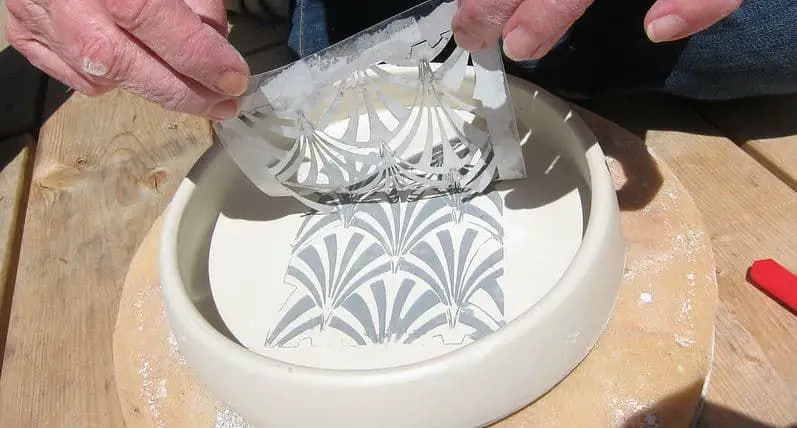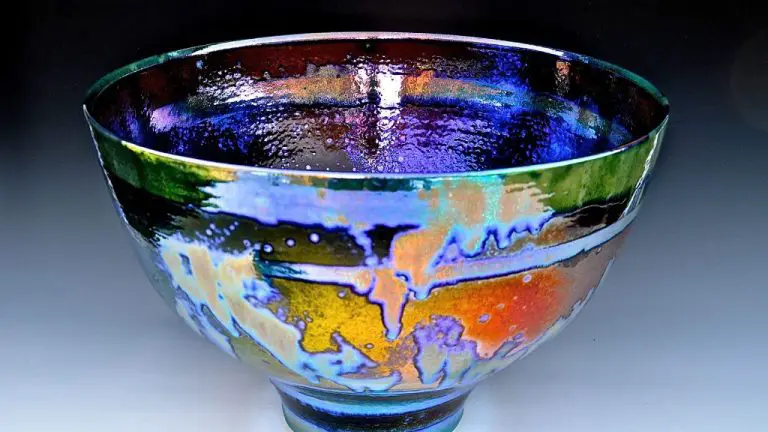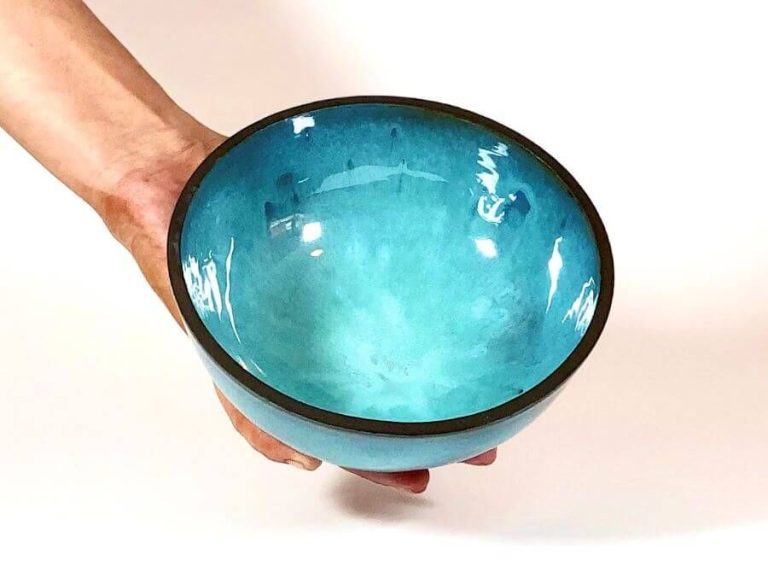What Underglaze Is Best For Sgraffito?
What is Sgraffito?
Sgraffito is a ceramic decoration technique that involves scratching through a surface to reveal a different colored clay underneath. The word “sgraffito” comes from the Italian word “sgraffiare” meaning “to scratch”.
Brief history of sgraffito: The origins of sgraffito pottery can be traced back to ancient Mesopotamia, where artisans used the technique to create detailed decorations on vessels. However, sgraffito is most closely associated with Italian Renaissance pottery from the 15th and 16th centuries. Italian potters revived the ancient technique and developed a new style featuring intricate black and white designs scratched through white slip to reveal reddish clay underneath (Source). This Italian Renaissance sgraffito style quickly spread throughout Europe and beyond.
Explanation of the sgraffito technique on pottery: The sgraffito process involves covering a ceramic object with a contrasting “slip” – usually a liquid clay mixture. This slip coat is allowed to dry partially before designs are scratched through to the underlying clay body using a tool like a knife or nail. The sgraffito scratching reveals the color and texture of the base clay in the drawn pattern. After scratching, the object is fired which sets the contrasts permanently. Sgraffito allows potters to create bold graphic designs and intricate fine line drawings by revealing colored clays under the slip.
Underglaze Overview
Underglaze is a ceramic coating that is applied to bisqueware, greenware, or unfired clay before a clear glaze is added on top. It allows for designs and patterns to show through the transparent glaze after firing. Underglazes come in two main types – slip underglazes and commercial underglazes.
Slip underglazes are made from clay, water, and pigments or stains. They have an earthy, matte look and feel similar to colored slip. Slip underglazes are ideal for blending colors smoothly.
Commercial underglazes are made from frit, silica, and pigments. They have brighter, more vibrant colors. Commercial underglazes are available in many forms like pencils, paints, and inks that allow for detailed designs.[1]
The key properties of underglaze are that it adheres well to unfired clay and bisqueware, it provides opaque coverage yet becomes transparent when fired under a glaze, and it enables decorative techniques like sgraffito carving and brushwork. Underglazes are lead-free, non-toxic, and food-safe once fired.[2]
Key Properties of Underglaze for Sgraffito
When selecting an underglaze for sgraffito, there are three key properties to consider: viscosity, color vibrancy, and absorbency into bisque.
Viscosity refers to the thickness and flow of the underglaze. For sgraffito, a medium viscosity is ideal. An underglaze that is too thin and runny will not hold crisp lines when scratched. However, one that is overly thick and gloopy can clog details. Aim for an underglaze with a viscosity like heavy cream that brushed on smoothly but stays put.[1]

Vibrant underglaze colors are important since the sgraffito designs will expose the color underneath. Opaque underglazes with intense, saturated hues work best to create high contrast. Underglazes that are too transparent or dull will result in subtle scratchings.[2]
Finally, the underglaze must properly absorb into the bisque to avoid flaking or peeling when scratched. Underglazes formulated for bisqueware have excellent adhesion. Test on a bisque tile first before applying to a piece.
Slip Underglazes
Slip underglazes are made from simple ingredients like clay, colorants, and water. They consist of a clay slip colored with stains, oxides, or pigments. Slip underglazes are applied to unfired clay in a leather-hard or bone-dry state before applying a clear glaze on top and firing the piece.
A basic slip underglaze recipe contains the following ingredients:
- Clay slip – usually a pottery casting slip or 50/50 mixture of clay and water
- Colorants – stains, oxides, mason stains, or ceramic pigments
- Water
- Dispersant – sodium silicate or Darvan
An example recipe is:
50g casting slip
10g stain or oxide
1 tsp sodium silicate
20g water
The pros of using slip underglazes for sgraffito are that they are very affordable and easy to make at home. They also blend and spread smoothly on the clay surface. The cons are they tend to be more translucent than commercial underglazes, so the color is not as vibrant. Too much colorant can also cause crawling issues.
For sgraffito techniques, slip underglazes work well since their softness makes carving and incising through them easier compared to commercial underglazes. Just be sure to test compatibility with the clear glaze used on top.
Commercial Underglazes
There are several major brands of commercial underglazes specially formulated for sgraffito techniques. These include products from Amaco, Spectrum, Duncan, Mayco, and Coyote among others. Many offer extensive lines of colors and finishes optimized for brushing, dipping, and scraping through in the sgraffito process.
Some key product lines to look for include:
- Amaco Underglazes – Offers Velvet Underglazes for a soft matte finish that enhances sgraffito designs.
- Spectrum Underglazes – Their Concepts line includes colors rated for mid and high temperatures ideal for sgraffito.
- Duncan Sgraffito – Specifically designed thicker body formulated not to run when scratched through.
- Mayco Designer Liner Underglazes – Allow precise liner applications perfect for detailed sgraffito.
The main benefits of commercial underglazes are the extensive range of colors, specialized formulations, and consistent results. However, they can be more expensive than mixing your own slips. But the convenience and reliability often makes them worth it for frequent sgraffito work.
Applying Underglaze for Sgraffito
Proper application of underglaze is crucial for creating clean sgraffito designs. Typically, two to three layers of underglaze are applied to leather-hard clay before carving into the surface for sgraffito. More underglaze needs to be applied compared to regular underglazing, in order to create enough colored thickness to carve through (1).
Each layer of underglaze should be allowed to dry completely before applying the next. Thicker applications will result in crisper sgraffito lines. Underglaze can be applied with a brush, sponge, or sprayed on. Ensure the underglaze is pressed into crevices to avoid trapped air bubbles. Let the underglaze dry thoroughly before carving to prevent pulling or dragging the color (2).
Firing schedule is also important when using underglaze for sgraffito. Fast firing can cause underglaze to bubble or burn out. Slow bisque firing between cone 04 and 06 allows the underglaze to fully mature before applying a transparent glaze. Use witness cones placed near the pieces to monitor heat work. Allow pieces to cool slowly in the kiln after firing (3).
(1) https://diamondcoretools.com/blogs/resources/how-to-make-sgraffito-pottery
(2) https://www.warmglass.com/sgraffito.html
(3) https://ceramicartsnetwork.org/daily/firing-techniques/electric-kiln-firing/tips-tricks-best-practices-bisque-firing-ceramics/
Creating Sgraffito Designs
When creating sgraffito designs, it’s important to first plan out your design. Consider the overall composition and patterns you want to carve. Sketch your design on paper first before applying it to the ceramic piece.
For carving sgraffito designs, specialized tools like sgraffito needles and sgraffito tools with multiple tips can be used. These allow you to carve fine lines and intricate details. However, basic household items like skewers, nails, and toothpicks also work well for many designs. Consider using tools with different widths and shapes for variation.
When carving sgraffito designs, work methodically and carefully. Apply even pressure and carve at a consistent angle and depth for best results. Consider carving outlines first, then going back to add finer details and textures. Removing slip in thin layers gives more control over the reveal of the underlayer colors.
Some best practices for sgraffito include:[www.study.com/learn/lesson/sgraffito-pottery-designs-ceramics.html]
- Carve lines close together for a neater look.
- Cross-hatching can build interesting textures.
- Vary line weights for dimension.
- Keep carving angles consistent.
With careful planning and technique, intricate sgraffito designs can be carved to produce stunning visual effects.
Clear Glazing Over Sgraffito
Choosing the right clear glaze is an important step for successful sgraffito designs. The clear glaze goes over the sgraffito design and colored underglaze to help accentuate the design and give it more visual contrast.
There are a few options when choosing a clear glaze for sgraffito:
- A basic clear glaze recipe – Many potters use a basic transparent glaze recipe over their sgraffito pieces. This can be a homemade clear glaze recipe or a commercial clear glaze. The glaze should be tested to ensure it fires transparent and glossy.
- A commercial clear glaze – Using a commercial clear glaze specially formulated for covering sgraffito can simplify the process. These glazes are designed to enhance sgraffito designs.[1]
- A protective glaze – Some potters prefer a clear glaze formulated to be more durable to protect the sgraffito design. These are often sold as “sgraffito glazes” by ceramic suppliers.
The clear glaze should be applied in a thin, even layer over the completed sgraffito design and underglaze. Multiple thin layers can be applied to achieve an optimal coating.
Firing schedule is also important when applying a clear glaze over sgraffito. The firing temperature should match the clear glaze instructions to ensure it melts evenly and flows smoothly over the sgraffito design.
Taking the time to test clear glaze options will help achieve beautiful distinct sgraffito designs that stand out when fired.
Tips for Successful Sgraffito
Here are some tips to help avoid common mistakes and troubleshoot problems when creating sgraffito:
Avoid Overworking the Clay
When scratching into leather-hard clay, it’s important not to overwork the surface. Scratching too much can cause the clay to dry out unevenly or become too smooth. Work in small sections and allow the clay to firm up again between passes.[1]
Use Proper Tools
Specialized sgraffito tools like carbide scrapers create cleaner lines than general pottery tools. Make sure your tools are sharp to get precise results. Dull tools tear the clay rather than slicing it cleanly.[1]
Work on Even Thickness
Sgraffito works best on an even clay thickness. Uneven surfaces make it hard to control the depth and achieve clean lines. Use slump molds or hump molds for curved surfaces.[2]
Keep Underglaze Moist
As you work in sections, keep a spray bottle handy to mist areas not being carved. This prevents the underglaze from drying out prematurely.
Clean Up Lines
Use a damp sponge to gently clean up any ragged edges on lines. Working while the clay is still moist allows for adjustments.
Control Glaze Application
When applying a clear glaze on top, use light, even coats. Heavy glaze filling in the sgraffito lines can ruin the design.
[1] “Scratching the Surface: A Guide to Sgraffito.” Ceramic Arts Network, Nov. 28, 2023. https://ceramicartsnetwork.org/daily/article/Scratching-the-Surface-A-Guide-to-Sgraffito
[2] “Sgraffito and safety question.” Ceramic Arts Daily Forums, Jan. 23, 2020. https://community.ceramicartsdaily.org/topic/21389-sgraffito-and-safety-question/
Best Underglaze Choices for Sgraffito
When selecting an underglaze for sgraffito techniques, you’ll want to consider certain properties to achieve the best results. Here are some top recommendations for commercial and slip underglazes:
Commercial Underglazes
Mayco Stroke & Coat: This versatile underglaze comes in a wide variety of colors and works well for sgraffito. It has excellent suspension properties that allow it to hold brushstrokes evenly. The matte finish provides good contrast with the glaze. One downside is that it can be more prone to flaking or scratching off if your sgraffito lines are too thick or deep.
Amaco Velvet Underglazes: These underglazes produce a super smooth velvety matte surface ideal for sgraffito. The rich pigments create nice contrast with glazes. Velvet underglazes are highly opaque and hold fine lines well. Just be careful not to apply too thickly or you may get crazing.
Slip Underglazes
Mid-fire Slip: Mixing your own slip from clay, water, and pigments allows tons of customization options. Mid-fire slips with higher fusion temperatures tend to work best for sgraffito, resisting scratching or flaking. You can control the texture and viscosity perfectly. It takes more effort to mix and apply evenly compared to commercial products.
Paperclay Slip: Adding paper pulp to a clay slip creates an ultra-smooth underglaze that keeps fine sgraffito lines crisp. The paper burns out during firing. Be sure to account for extra shrinkage. Test fusion temps to avoid too much burnout bubbling.
Whichever product you choose, the key is finding an underglaze that fuses well to the clay body without flaking or bleeding under the glaze layer. Always test combinations before applying to finished pieces. With the right underglaze and proper sgraffito techniques, you can create intricate and beautiful designs.


